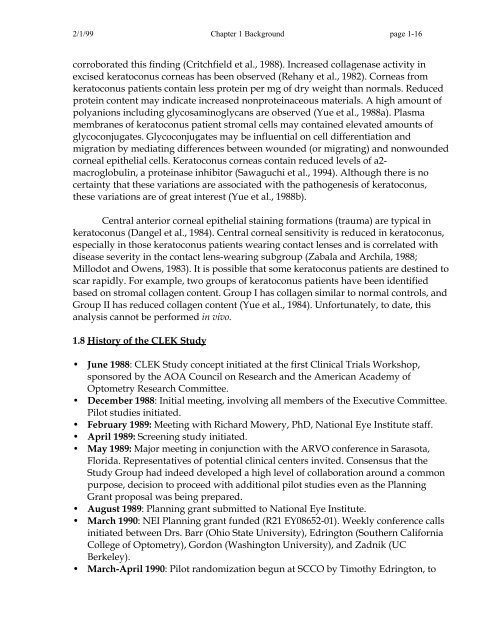OM t of c.iii - Vision Research Coordinating Center - Washington ...
OM t of c.iii - Vision Research Coordinating Center - Washington ...
OM t of c.iii - Vision Research Coordinating Center - Washington ...
Create successful ePaper yourself
Turn your PDF publications into a flip-book with our unique Google optimized e-Paper software.
2/1/99 Chapter 1 Background page 1-16<br />
corroborated this finding (Critchfield et al., 1988). Increased collagenase activity in<br />
excised keratoconus corneas has been observed (Rehany et al., 1982). Corneas from<br />
keratoconus patients contain less protein per mg <strong>of</strong> dry weight than normals. Reduced<br />
protein content may indicate increased nonproteinaceous materials. A high amount <strong>of</strong><br />
polyanions including glycosaminoglycans are observed (Yue et al., 1988a). Plasma<br />
membranes <strong>of</strong> keratoconus patient stromal cells may contained elevated amounts <strong>of</strong><br />
glycoconjugates. Glycoconjugates may be influential on cell differentiation and<br />
migration by mediating differences between wounded (or migrating) and nonwounded<br />
corneal epithelial cells. Keratoconus corneas contain reduced levels <strong>of</strong> a2-<br />
macroglobulin, a proteinase inhibitor (Sawaguchi et al., 1994). Although there is no<br />
certainty that these variations are associated with the pathogenesis <strong>of</strong> keratoconus,<br />
these variations are <strong>of</strong> great interest (Yue et al., 1988b).<br />
Central anterior corneal epithelial staining formations (trauma) are typical in<br />
keratoconus (Dangel et al., 1984). Central corneal sensitivity is reduced in keratoconus,<br />
especially in those keratoconus patients wearing contact lenses and is correlated with<br />
disease severity in the contact lens-wearing subgroup (Zabala and Archila, 1988;<br />
Millodot and Owens, 1983). It is possible that some keratoconus patients are destined to<br />
scar rapidly. For example, two groups <strong>of</strong> keratoconus patients have been identified<br />
based on stromal collagen content. Group I has collagen similar to normal controls, and<br />
Group II has reduced collagen content (Yue et al., 1984). Unfortunately, to date, this<br />
analysis cannot be performed in vivo.<br />
1.8 History <strong>of</strong> the CLEK Study<br />
• June 1988: CLEK Study concept initiated at the first Clinical Trials Workshop,<br />
sponsored by the AOA Council on <strong>Research</strong> and the American Academy <strong>of</strong><br />
Optometry <strong>Research</strong> Committee.<br />
• December 1988: Initial meeting, involving all members <strong>of</strong> the Executive Committee.<br />
Pilot studies initiated.<br />
• February 1989: Meeting with Richard Mowery, PhD, National Eye Institute staff.<br />
• April 1989: Screening study initiated.<br />
• May 1989: Major meeting in conjunction with the ARVO conference in Sarasota,<br />
Florida. Representatives <strong>of</strong> potential clinical centers invited. Consensus that the<br />
Study Group had indeed developed a high level <strong>of</strong> collaboration around a common<br />
purpose, decision to proceed with additional pilot studies even as the Planning<br />
Grant proposal was being prepared.<br />
• August 1989: Planning grant submitted to National Eye Institute.<br />
• March 1990: NEI Planning grant funded (R21 EY08652-01). Weekly conference calls<br />
initiated between Drs. Barr (Ohio State University), Edrington (Southern California<br />
College <strong>of</strong> Optometry), Gordon (<strong>Washington</strong> University), and Zadnik (UC<br />
Berkeley).<br />
• March-April 1990: Pilot randomization begun at SCCO by Timothy Edrington, to
















